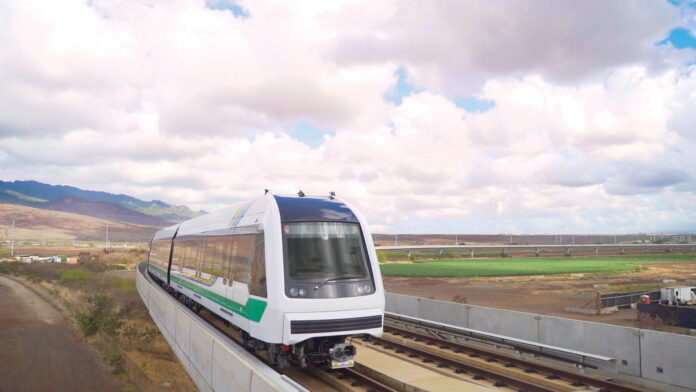For the past 11 years, Hawaii residents and visitors on the island of Oahu have watched as large concrete columns supporting an elevated railway stretched across the island. It’s changed the landscape, blocking views and hovering above roadways. Its purpose is to alleviate traffic woes, as Hawaii consistently ranks as having the worst traffic in the country.
The $10 billion Honolulu rail project’s complete 20-mile railway was originally supposed to be done in 2020, but it is estimated that it won’t be 100% complete until around March 2031.
However, the first segment — 10.75 miles of it — is ready and opening on June 30. This stretch of rail is mostly suburban, starting in East Kapolei and ending in Central Oahu at Aloha Stadium.
“The views capture the beauty of Oahu that is rarely seen to by the public,” said Travis Ota, spokesperson for the city and county of Honolulu’s Department of Transportation Services, in an email. “From above, riders can soar past traffic during the busiest commute hours, passing by shopping centers, neighborhoods, going over freeways, and getting a good look of the south shore.” Riders also get a unique viewpoint of Pearl Harbor as the rail passes by.

A map shows the different Honolulu rail segments. The first segment will open on June 30.
Honolulu Authority for Rapid Transportation (HARTThere are nine stations on this route, where passengers can hop on or off. They include stops at residential neighborhoods, University of Hawaii West Oahu, Leeward Community College, Pearl Highlands, Pearlridge (near the mall on Kamehameha Highway) and Halawa/Aloha Stadium. Five of the stations have park-and-ride options, and most of the stations have TheBus stops. There are no shops or places to eat at the stations, and riders should not plan on there being bathrooms either.
As of now, the first segment of rail that’s opening does not connect to any visitor hubs, but visitors planning on traveling around the island using public transportation will find it to be a good alternative to TheBus for this part of the island.

A stretch of the Honolulu rail passes over the H-1 freeway.
Logan DunnThe city and county of Honolulu recently introduced HOLO cards, which work for TheBus and the rail. You can’t use a TheBus pass for the rail. HOLO cards can be purchased, loaded and reloaded online and at ABC Stores, 7-Elevens and other retail outlets.
“The benefit of HOLO cards include automatic fare capping and passes,” Ota said in an email. “If you tap your HOLO cards to ride on TheBus or rail, you will get a transfer pass that will allow you to take another bus or rail within 2.5 hours. With fare capping, riders will not spend more than a daily pass (e.g. an Adult fare on TheBus and rail is $3.00 and a daily pass is $7.50) in a single day.”
The Halawa Station is as close to Honolulu as this initial segment goes. It’s about 8 miles from Honolulu and 10 miles from Waikiki. Visitors may want to note that this station, which has a park-and-ride option, is near Aloha Stadium.

The Halawa Station has a park-and-ride lot and is within walking distance of Aloha Stadium in Halawa, Hawaii.
Courtesy HARTThough the stadium is set for renovation and will not be hosting games anytime soon, it still holds its popular Aloha Stadium Swap Meet and Marketplace, which it has been running since 1979, on Wednesdays, Saturdays and Sundays. The swap meet is about 100 yards away from the Halawa Station and features more than 400 vendors, with many selling a large assortment of Hawaii souvenirs.
Also, if walking is an option, the Pearl Harbor Visitor Center is about a half-mile away from the Halawa Station.
This initial segment does not connect to Honolulu’s Daniel K. Inouye International Airport. That will be part of the next segment, which is expected to be completed and transferred to the city in mid-2025. The rail project also has no plans to connect to Waikiki, but it will eventually end at the large open-air mall, Ala Moana Center, just outside of it.



